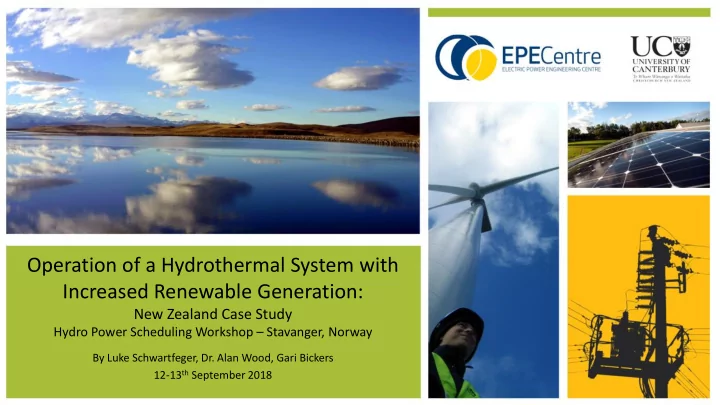

Operation of a Hydrothermal System with Increased Renewable Generation: New Zealand Case Study Hydro Power Scheduling Workshop – Stavanger, Norway By Luke Schwartfeger, Dr. Alan Wood, Gari Bickers 12-13 th September 2018
Contents • Background of New Zealand System • Context of Study • Model and Modelling Tool • Analysis
Hydro North and South Island Inflow Percentiles
Hydro North and South Island Inflow Percentiles
Demand New Zealand Demand Percentiles • Hydro-Demand temporal and geographical mismatches overcome the limited hydro storage
Context • Near 100% Renewable Generation target by 2035 • > 80% Renewable at present • Candidate generation: Generation Installed Cap. Consented Cap. Type (MW) (MW) Wind 689 2500 Geothermal 978 300 • Rely on fossil fuel (FF) generation during low inflow years (dry years) • Electricity Market energy payment based – Disincentive to construct renewable generation GREEN Grid 7
Context • Challenges in Islanded, Highly Renewable System: – Dry year risk – Supplying peak demand – Incentivise market to construct renewable generation • Purpose of Study: – Examine FF generation operation (capacity factors) in New Zealand with additional wind and geothermal generation – Determined with an optimal hydrothermal dispatch tool
Model • 2 AC systems connected by a “bi - pole” HVDC link • 2 node, 2 reservoir – Island’s hydro schemes are aggregated • HVDC ‘one - pole trip’ risk
Modelling Tool – ISO DP Part 1 Part 2
Modelling Tool – ISO DP • DP – 2 year time span; 2 nd year to estimate end-of-year WVs – 30 minute time interval to capture capacity constraints – 6 x 21 storage levels (126 discrete storage points) • Both DP and Forward Dispatch use a Optimal Generation Dispatch
Ƹ Ƹ Ƹ Ƹ Generation Dispatch (1) • Linear programming formulation – Capacities of storage, generation and transmission; Demand satisfaction; Transmission losses approximated with piecewise linear function; HVDC one pole trip • Objective Function: min 𝑑 ℎ ∙ ො ℎ + 𝑑 𝑔𝑔 ∙ ො 𝑔𝑔 + 𝑑 𝑜 ∙ ො 𝑜 𝑑𝑏𝑞 = 385 1000 𝑈 𝑂𝑎𝐸 ; 748 𝑈 𝑁𝑋 𝑑 𝑔𝑔 = 10 𝑔𝑔 ො 100 500 • 𝑜 - Fictious Non-Supply Generation ො
Generation Dispatch (2) • Outputs: 1. DP: WVs per node. Shadow prices of demand satisfaction or one-pole trip risk constraints ∗ ) Forward Dispatch: Optimal generation dispatch ( ො 2. • Input: Net Demand, Hydro costs ( Ƹ 𝑑 ℎ ) 𝑑 ℎ t interpolated from – DP: Ƹ 𝑋𝑊 𝑢 + 1 – Forward Dispatch: Average WV function
Analysis: Case Study • NZ 2015 generation portfolio and data • 9 generation portfolios • Scaled 2015 Wind and Geothermal production to emulate additional generation
System Fossil Fuel Generation Capacity Factors Wind Geothermal Wind / Geo
Duration Curves of FF Generation: Wind Least Cost FF ($10) Moderate Cost FF ($100) Highest Cost FF ($1000)
Duration Curves of FF Generation: Dry Years Least Cost FF 100% Capacity Factors for 0 – 300 MW Geothermal Moderate Cost FF
Future Work • Benchmark against ESO formulation • Evaluate importance of 30 min. time interval WV functions • Include more wind profiles
20 Thank you to our industry members of the Power Engineering Excellence Trust
Recommend
More recommend